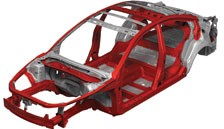Alternative fuels have been getting a great deal of media coverage, with the birth of the latest generation electric vehicles and a burgeoning choice of hybrid models.
However, these models seem to have generated far more column inches than perhaps sales justify.
And despite the predictions for growth over the next decade, internal combustion engines will still be the dominant power source for road vehicles for many years to come.
It has prompted Mazda to adopt a new strategy for its next generation of cars, starting in 2012.
The company is aiming for industry-leading efficiency from conventional engines through improving the technology of the engines themselves, as well as producing better gearboxes and lighter cars.
Under the banner of Skyactiv, Mazda will implement this new strategy across its range starting with the new CX-5 compact crossover car in 2012.
AM was given access to early prototypes using the new chassis and engine technology.
Skyactiv body and chassis
Targets:
- Increase rigidity
- Reduce weight
- Top-class crash safety
The increased weight of vehicles over the years in response to tougher crash safety tests has made improving fuel efficiency more difficult.
Key to improving fuel efficiency is reducing component weights. Mazda had already begun reducing vehicle weight compared with predecessors on the latest version of the Mazda2.
Mazda said it did not want to resort to specialist lightweight materials such as aluminium or carbon fibre, because they were likely to increase costs.
Its target is an 8% weight reduction for new generation models – about 100kg lighter than their predecessors.
It has increased the number of spot welds and the use of high-strength steel to help reduce the mass of steel used and redesigned the structures used to dissipate energy in crashes.
The result should be lower overall weight, while maintaining high levels of crash protection for occupants.
Skyactiv engines
Targets:
- Reduce fuel consumption and emissions of petrol and diesel engines
- Achieve Euro VI for diesel without exhaust after-treatment
- Retain strong power and torque outputs.
Separate approaches were needed for petrol and diesel engine development under Skyactiv.
Key to improving diesel efficiency was reducing the compression ratio of the engine, which allows more efficient combustion and a reduction in the level of NOx and particulate emissions.
Mazda has used components that eliminate the risk of misfiring that can affect a low compression ratio diesel engine. The result is that the new engine, called Skyactiv-D, has a 20% improvement in efficiency compared to Mazda’s current Euro V-compliant 2.2-litre diesel engine.
Conversely, for the Skyactiv-G petrol engine, a higher compression ratio was needed for more efficient combustion.
Mazda wanted to achieve better fuel economy and lower emissions without downsizing engines and adding turbochargers.
It has also resulted in improved torque at lower revs compared to Mazda’s current 2.0-litre petrol engine.
Both petrol and diesel engines are also lighter than before.
Skyactiv transmissions
Targets:
- Improve fuel economy
- Quick and direct shifting auto
- Lightweight, compact manual with MX-5 shift feel.
Mazda is producing six-speed manual and automatic gearboxes under the Skyactiv banner, and is keen to make the automatic available with diesel.
After evaluation of conventional automatic transmission, dual clutch gearboxes and CVTs, Mazda decided drivers would be better served with a conventional auto with improved fuel consumption and better responsiveness.
The Skyactiv-Drive auto achieves an efficiency saving of between 4% and 7% compared with the current automatic transmission.
The Skyactiv-MT manual has a shorter shift action than before, but also requires less effort. It is also lighter and more compact than the current Mazda manual gearbox.
Both automatic and manual transmissions are industry-leading in terms of torque capacity versus the weight of the gearboxes.
Mazda says no more than six gears are needed because, as the engines develop higher torque than before,
the gearing can be set to maintain low fuel consumption while remaining responsive.
Behind the wheel
We drove hand-built prototypes using Skyactiv engine, transmission and chassis technology under Mazda6 shell.
We tried petrol and diesel versions, with manual and automatic transmissions and can confirm that the Skyactiv strategy appears to be paying off.
The vehicles we drove had all the sharp responses we have come to expect from modern Mazdas.
The diesel engine produced 175bhp and felt as keen as the current Mazda 2.2-litre diesel.
The petrol version also felt alert at low revs, while the short gearshift ensured the whole package was nimble.
Mazda suggests the first car to use Skyactiv technology, the CX-5, would have CO2 emissions lower than 120g/km for the front-wheel drive diesel version.
If this is true, Mazda could be on the verge of delivering the most significant development for conventional fuel cars for many years.














Login to comment
Comments
No comments have been made yet.